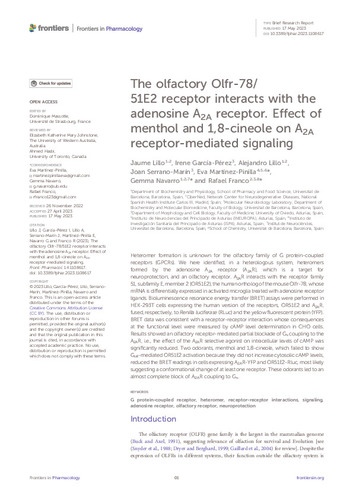The olfactory Olfr-78/51E2 receptor interacts with the adenosine A2A receptor. Effect of menthol and 1,8-cineole on A2A receptor-mediated signaling
Autor(es) y otros:
Palabra(s) clave:
G protein-coupled receptor
Heteromer
Receptor-receptor interactions
Signaling
Adenosine receptors
Human olfactory receptor
51E2 olfactory receptor
Fecha de publicación:
Versión del editor:
Citación:
Resumen:
Heteromer formation is unknown for the olfactory family of G protein-coupled receptors (GPCRs). We here identified, in a heterologous system, heteromers formed by the adenosine A2A receptor (A2AR), which is a target for neuroprotection, and an olfactory receptor. A2AR interacts with the receptor family 51, subfamily E, member 2 (OR51E2), the human ortholog of the mouse Olfr-78, whose mRNA is differentially expressed in activated microglia treated with adenosine receptor ligands. Bioluminescence resonance energy transfer (BRET) assays were performed in HEK-293T cells expressing the human version of the receptors, OR51E2 and A2AR, fused, respectively, to Renilla luciferase (RLuc) and the yellow fluorescent protein (YFP). BRET data was consistent with a receptor-receptor interaction whose consequences at the functional level were measured by cAMP level determination in CHO cells. Results showed an olfactory receptor-mediated partial blockade of Gs coupling to the A2AR, i.e., the effect of the A2AR selective agonist on intracellular levels of cAMP was significantly reduced. Two odorants, menthol and 1,8-cineole, which failed to show Golf-mediated OR51E2 activation because they did not increase cytosolic cAMP levels, reduced the BRET readings in cells expressing A2AR-YFP and OR51E2-Rluc, most likely suggesting a conformational change of at least one receptor. These odorants led to an almost complete block of A2AR coupling to Gs.
Heteromer formation is unknown for the olfactory family of G protein-coupled receptors (GPCRs). We here identified, in a heterologous system, heteromers formed by the adenosine A2A receptor (A2AR), which is a target for neuroprotection, and an olfactory receptor. A2AR interacts with the receptor family 51, subfamily E, member 2 (OR51E2), the human ortholog of the mouse Olfr-78, whose mRNA is differentially expressed in activated microglia treated with adenosine receptor ligands. Bioluminescence resonance energy transfer (BRET) assays were performed in HEK-293T cells expressing the human version of the receptors, OR51E2 and A2AR, fused, respectively, to Renilla luciferase (RLuc) and the yellow fluorescent protein (YFP). BRET data was consistent with a receptor-receptor interaction whose consequences at the functional level were measured by cAMP level determination in CHO cells. Results showed an olfactory receptor-mediated partial blockade of Gs coupling to the A2AR, i.e., the effect of the A2AR selective agonist on intracellular levels of cAMP was significantly reduced. Two odorants, menthol and 1,8-cineole, which failed to show Golf-mediated OR51E2 activation because they did not increase cytosolic cAMP levels, reduced the BRET readings in cells expressing A2AR-YFP and OR51E2-Rluc, most likely suggesting a conformational change of at least one receptor. These odorants led to an almost complete block of A2AR coupling to Gs.
ISSN:
Colecciones
- Artículos [37548]
- Investigaciones y Documentos OpenAIRE [8420]
- Morfología y Biología Celular [177]
Ficheros en el ítem

Métricas
Compartir
Estadísticas de uso
Metadatos
Ítems relacionados
Mostrando ítems relacionados por Título, autor o materia.




